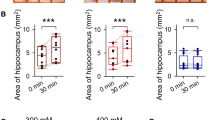Summary
This paper describes the early stages of impregnation by the Golgi method. Sections of aldehyde-fixed and potassium dichromate-treated cerebral cortex were mounted on glass slides and cover slipped. The dichromate solution was replaced by silver nitrate solution and events in the section were followed and recorded by time lapse microphotography and video recording until stopped by replacement of silver nitrate solution by glycerol. The sections were subsequently prepared for electron microscopy (EM) study.
In sections about 2×2 mm and 100 μm thick a fine, dark granular precipitate formed at the edges within the first minutes of exposure to silver nitrate and a wave of brownish colouration spread to a depth of about 0.3 mm. After approximately 7 min, shrub-like focal precipitates (nucleation centres) appeared in the sections. From these nucleation centres (but also from the section edges) thread-like ‘outgrowths’, usually identified as dendrites, spread into somata. Sometimes impregnation began within the soma and spread into dendrites. The rate of impregnation (i.e., of silver chromate deposition within dendrites) was typically 1–7 μm mins-1, faster in the earlier stages (up to 3 μm ss-1) and very slow after 30 min, by which time many neurons were more or less fully impregnated.
The dimensions of the section, the width of an agar frame around the sections, and the frequency with which the silver nitrate in the sections was replenished all affected the extent and time course of the impregnation.
By EM the earliest intracellular deposits consisted of tubulolamellar formations which did not cross plasma or endocellular membrane boundaries and which contained irregularly shaped and scattered granules, initially about 10 nm in diameter. The latter progressively enlarged and coalesced as the tubulolamellar formations extended, eventually to fill the cross-sectional area of neuronal processes and cell bodies.
These observations shed light on why so few neurons become impregnated with the Golgi method. Impregnation occurred only in those cells a part of which was within a nucleation centre.
Similar content being viewed by others
References
Blackstad, T. W. (1965) Mapping of experimental axon degeneration by electron microscopy of Golgi preparations.Zeitschrift für Zellforschung 67, 819–34.
Blackstad, T. W. (1970) Electron microscopy of Golgi preparations for the study of neuronal relations. InContemporary Research Methods in Neuroanatomy (edited byNauta, W. J. H. &Ebbesson, S. O. E.), pp. 186–216. Berlin-Heidelberg-New York: Springer.
Blackstad, T. W. (1975) Golgi preparations for electron microscopy: controlled reduction of silver chromate by ultraviolet illumination. InGolgi Centennial Symposium. Proceedings (edited by Santini, M.), pp. 123–132. New York: Raven Press.
Blackstad, T. W. (1981) Tract tracing by electron microscopy of Golgi preparations. InNeuroanatomical TractTracing Methods (edited by Heimer, L. & Robards, M. J.), pp. 407–440. New York and London: Plenum Publishing Corporation.
Braitenberg, V., Guglielmotti, V., &Sada, E. (1967) Correlation of crystal growth with the staining of axons by the Golgi procedure.Stain Technology 42, 277–83.
Chan-Palay, V. (1973) A brief note on the chemical nature of the precipitate within nerve fibres after the rapid Golgi reaction: selected area diffraction in high voltage electron microscopy.Zeitschrift für Anatomie und Entwicklungs Geschichte 139, 115–17.
Chan-Palay, V. &Palay, S. L. (1972) High voltage electron microscopy of rapid Golgi preparations. Neurons and their processes in the cerebellar cortex of monkey and rat.Zeitschrift für Anatomie und Entwicklungs Geschichte 137, 125–52.
Fregerslev, S., Blackstad, T. W., Fredens, K., &Holm, M. J. (1971) Golgi potassium-dichromate silver nitrate impregnation: nature of the precipitate studied by X-ray powder diffraction methods.Histochemie 25, 63–71.
Freund, T. F. &Somogyi, P. (1983) The section — Golgi impregnation procedure. 1. Description of the method and its combination with histochemistry after intracellular iontophoresis or retrograde transport of horseradish peroxidase.Neuroscience 9, 463–74.
Gabbott, P. L. &Somogyi, J. (1984) The ‘single’ section Golgi-impregnation procedure: methodological description.Journal of Neuroscience Methods 11, 221–30.
Golgi, C. (1873) Sulla struttura della sostanza grigia dell cervello.Gazzetta medica lombarda 33, 244–46.
Harris, K. M., Cruce, W. L. R., Greenough, W. T. &Teyler, T. J. (1980) A Golgi impregnation technique for thin brain slices maintainedin vitro.Journal of Neuroscience Methods 2, 363–71.
Landas, S. &Phillips, M. I. (1982) Staining of human and rat brain Vibratome sections by a new Golgi method.Journal of Neuroscience Methods 5, 147–51.
Pasternak, J. F. &Woolsey, T. A. (1975) On the ‘selectivity’ of Golgi-Cox method.Journal of Comparative Neurology 160, 307–12.
RamÓn-Moliner, E. (1970) The Golgi-Cox technique. InContemporary Research Methods in Neuroanatomy (edited byNauta, W. J. H. &Ebbesson, S. O. E., pp. 186–216. Berlin-Heidelberg-New York: Springer.
Ribi, W. A. &Berg. G. J. (1980) Light and electron microscopic structure of Golgi-stained neurons in the vertebrate brain (new rapid Golgi procedure).Cell and Tissue Research 205, 1–10.
Scheibel, M. E. &Scheibel, A. B. (1970) The rapid Golgi method. Indian Summer or renaissance? InContemporary Research Methods in Neuroanatomy (edited byNauta, W. J. H. &Ebbesson, S. O. E., pp. 1–11. Berlin-Heidelberg-New York: Springer.
Scott, G. L. &Guillery, R. W. (1974) Studies with the high voltage electron microscope of normal, degenerating, and Golgi impregnated neuronal processes.Journal of Neurocytology 3, 567–90.
Stell, W. K. (1965) Correlation of retinal cytoarchitecture and ultrastructure in Golgi preparations.Anatomical Record 153, 389–97.
Valverde, F. (1970) The Golgi method. A tool for comparative structural analyses. InContemporary Research Methods in Neuroanatomy (edited byNauta, W. J. H. &Ebbesson, S. O. E.), pp. 12–31. Berlin-Heidelberg-New York: Springer.
Author information
Authors and Affiliations
Rights and permissions
About this article
Cite this article
Špaček, J. Dynamics of the Golgi method: a time-lapse study of the early stages of impregnation in single sections. J Neurocytol 18, 27–38 (1989). https://doi.org/10.1007/BF01188421
Received:
Revised:
Accepted:
Issue Date:
DOI: https://doi.org/10.1007/BF01188421




